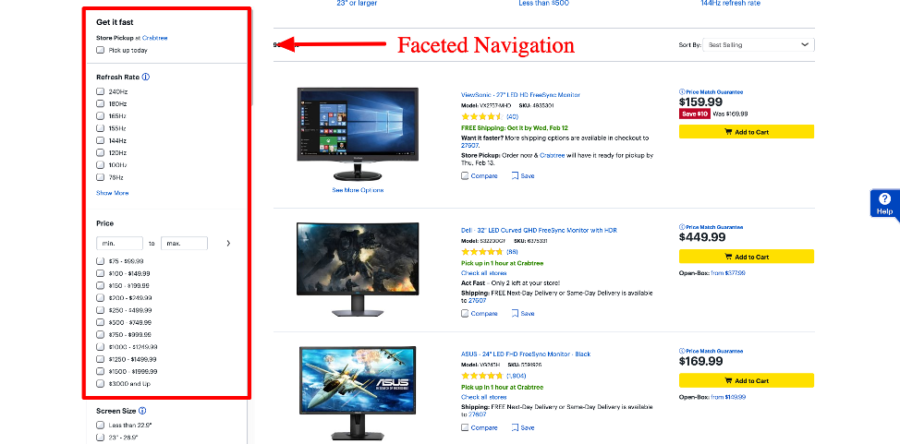Table of Contents
SEO on eCommerce sites can be extremely challenging. eCommerce sites can have massive amounts of pages due to factors such as large inventories, faceted navigation, and robust site functionality. Due to the size of these sites, SEO becomes a much larger challenge as solutions oftentimes need to be scaled across thousands or millions of URLs.
Related Content:
At Go Fish Digital, we run into our fair share of eCommerce sites and I thought it would be helpful to show you our eCommerce SEO checklist. While there are a lot of items on this checklist below, here are some of the highest priority items:
Our Ecommerce SEO Checklist:
- Set up Ecommerce Tracking
- Check Google’s Index Coverage report
- Review the site’s log files
- Limit JavaScript rendered content
- Map out the site architecture
- Scale internal linking
- Audit faceted navigations
- Use global title tags & meta descriptions
- Perform keyword research
- Reclaim broken backlinks
You can review the entire checklist below to see how we analyze eCommerce sites.
Table Of Contents
- Analytics
- Crawling & Indexing
- Website Architecture
- Keyword Research
- On-Page SEO
- Site Performance
- Backlinks
- Guides By Platform
- Ecommerce Tools
1. Analytics
Proper analytics are essential to the success of any SEO campaign. This is especially true for eCommerce sites. Due to their size, these sites often collect enormous amounts of data around traffic, engagement, rankings, conversions and more. This data can be a key driver for many digital and external marketing initiatives. For these reasons, it’s imperative that your site is tracking as much clean data as possible.
1a. Google Analytics
- Ensure Google Analytics is installed and tracking properly. You can confirm this by filtering down to your session and confirming a single session in Real-Time reporting.
- Implement Ecommerce Tracking to track revenue in Google Analytics
- Create other goals in Google Analytics: email subscriptions, cart adds, account sign-ups
- Set up event tracking for other key user actions: video plays, CTA clicks
- Enable Site Search tracking to monitor internal site searches
- Turn on Enhanced Ecommerce reporting
- Create filters to remove any internal traffic or bot traffic from getting reported
1b. Google Search Console
- Ensure that a property has been created and verified for Google Search Console
- Submit your sitemap.xml
2. Crawling & Indexing
You can have the best content in the world, but if it isn’t getting crawled and indexed, users won’t be able to discover it in the search engines. Generally, eCommerce sites have more robust functionality than standard sites and this functionality can cause large scale issues with how your site is crawled and indexed. There are a good number of elements that impact these initiatives on your website.
2a. Site Crawl
- Perform a crawl of the site using Screaming Frog. If the site is extremely large, you may need to set up a virtual machine using AWS to crawl from the cloud.
- Monitor to see if the crawl can finish. If it appears it cannot, there may be significant cawl budget issues.
- Review any internal 3xx/4xx status codes. If global elements are creating these then consider fixing these issues first.
- Check for any instances of non-indexable URLs (“Noindex”, “Canonoicalised”, “Blocked by Robots.txt”. Determine why these are not set to be indexable pages and if any adjustments should be made.
- Save the crawl. This will allow it to be easily uploaded at a later date.
2b. Sitemap.xml
- Check to see if your site is generating a sitemap.xml. If not, create a new sitemap.xml file.
- Crawl the sitemap.xml.
- Ensure that all key pages are included
- Remove any non-indexable pages (3xx, 4xx, canonicalized, ”noindex”)
- If the site utilizes a sitemap index file, ensure that all child sitemaps are grouped into clear categories (Brands, Products, Categories, Blogs, etc). If the child sitemaps will be large, consider splitting them up into additional sitemap index files.
2c. Robots.txt
- Check to see if the site is generating a robots.txt file. This should be located at example.com/robots.txt
- Review the “Disallow” commands. Are these commands accidentally blocking content that should be crawlable or have a large number of backlinks pointing to them?
- Check that the robots.txt is blocking the crawl of URLs that shouldn’t be indexed (i.e. parameterized URLs).
- Ensure a link to the sitemap.xml is present in the robots.txt
2d. Index Coverage Report
- Identify the primary crawler of your website in Google’s Index Coverage
- Check the “Excluded” report for URLs that should be getting indexed. Higher priority statuses include “Crawled – currently not indexed”, “Discovered – currently not indexed”, “Duplicate, Google chose different canonical than user”.
- Check the “Valid” report for URLs that shouldn’t be getting indexed. The “Indexed, not submitted in sitemap” status can be good to audit for these URLs.
2e. Log File Analysis
- Review the log files from the site. This can be done with tools such as the Screaming Frog Log Analyser.
- Note the most frequently crawled URLs on the site. Are there high priority landing pages that are missing from the most frequently crawled pages? If so, determine ways to improve their internal linking and accessibility.
- Identify any URLs that are getting crawled that should be (i.e. parameterized URLs). Adjust the site’s crawl settings to block the crawl/indexation of these URLs.
- Fix any commonly crawled 3xx/4xx status codes.
- Identify orphaned content that has been crawled but does not receive any traffic.
- Review the log files for any other crawl data that stands out. Screaming Frog has a great guide to log file analysis.
2f. JavaScript Audit:
- Turn off JavaScript in your browser and manually review key page types. Note which global content elements are dependent on JavaScript to load. You can also use the View Rendered Source extension to compare the original source code to the DOM.
- Use Google’s URL Inspector to render these pages. Check to ensure Googlebot is able to crawl and index these elements.
- For content you’re unsure is loading properly, use “site:” search operators to check Google’s index for that content.
- For key content that is unable to be indexed, consider eliminating JavaScript dependencies.
2g. Faceted Navigation/Sorting:
- Check for faceted navigation. Manually review to see if this navigation is generating a large number of URLs.
- Use the “site:” & “inurl:” search operators in Google to determine if parameterized URLs are getting indexed.
- Review crawl directives associated with URLs generated by the faceted navigation (canonicals, “nofollow” tags, robots.txt, URL parameters report). If the log file analysis shows that undesirable URLs are still getting crawled, adjustments may need to be made to these crawl directives. This post provides a great guide on how to adjust those crawl directives and the pros and cons of each option.
- Monitor the site’s crawling and indexation prin Search Console once adjustments have been made.
3. Website Architecture
When Google crawls large sites, it’s extremely important that it’s able to access and understand all of the URLs it’s encountering. Having an intuitive website architecture is essential for ensuring that Google is able to access all of your product listing and product description pages. As well, intelligent architecture allows Google to properly categorize your content into logical parent and child categories. Here is how we typically review a given site’s architecture.
3a. Navigation:
- Ensure that all of your key category pages are included in your navigation. This will allow Google and users to easily access them.
- Review the naming conventions used in the navigation. Ensure they’re optimized for your target keywords.
- Review how many total navigation options the site has. Ideally, the navigation will provide users with links to the most useful categories without “flattening” the architecture too much.
- Review the categorization of navigation. Ensure that subcategories are properly grouped into logical parent categories.
3b. Internal Linking:
- Identify product listing pages that use infinite scrolling. Ensure that any infinite scrolling is SEO-friendly.
- Review the paginated internal linking. Consider adding a link to the last page in the series if one isn’t present. This makes it easier for Google to crawl products deeper in the site architecture.
- Review the site crawl to find pages that are deep in the architecture of the site. If certain groups of pages consistently have crawl depths of 4+, consider adding internal links to them.
- Remove tracking parameters from any internal links
- Ensure product description pages utilize “Related Items” internal links. This will naturally improve Google’s crawl to other product description pages and help improve conversions and user engagement.
- Create an HTML sitemap that lists all key product categories. This will provide an additional step of ensuring that key product listing and description pages aren’t too deep in the site architecture.
4. Keyword Research
Like any site, it’s important to understand the keywords that are most likely to generate revenue for your company. By understanding and properly prioritizing your keywords, you’ll know which SEO initiatives and content are most likely to move the needle in terms of revenue. Here is a great process to find the most valuable keywords for your site.
- Create a new spreadsheet that will be your “Master Keyword” sheet.
- Export your keywords from Search Console’s “Search Results” report. Add keywords that generate the majority of your clicks/impressions.
- Navigate to the “Search Queries” report in Google Analytics. Identify keywords that generate the majority of revenue from Google AdWords. Add these keywords to the “Master Keyword” sheet.
- Use tools such as AHREFs to perform a content gap analysis of you and your competitors to determine keywords where they’re ranking well and you’re not. Add any core keywords to the “Master Keyword” sheet.
- Map all keywords to associated landing pages on your site. Ideally, there will be a 1:1 match between a particular keyword group and an individual landing pages
- For keywords with no associated page, consider creating a new one to be mapped to that keyword. This may be able to be done by using existing content created by the faceted navigation or the site’s internal search data.
- Upload all of your keywords to your rank tracking solution of choice.
5. On-Page SEO
Of course, on-page SEO is still highly relevant to eCommerce sites. This means ensuring that you’re sending strong on-page signals for your relevant keywords. The primary difference between standard sites and eCommerce is that any on-page changes will need to be made at scale. The following process can help you find templated solutions to optimize your product listing and product description pages.
5a. Meta Data
- Optimize all of your page category and product title tags. If your site is large this may need to be done programmatically.
- Optimize all of your page category and product meta descriptions. Once again, if your site is large, this may need to be done programmatically.
Product Listing Pages
- Ensure that the product listing page represents logical overall categories that users would be searching for. Consider consolidating categories that are too similar or splitting up categories that are too different.
- Review the individual product information listed on product listing pages (pricing, reviews, description, etc). Should additional content be included on the product listing page to give users even more information?
- Audit your product listing pages to ensure that individual products match the category they’re in.
- Research if using an intermediary category page is a good fit for certain product listing pages. These pages act as content hubs for more broad categories and don’t include links to description pages.
Product Pages
- Ensure that all product pages have unique descriptions. This will help avoid duplicate content from getting indexed by Google.
- Review product pages to ensure that key information is included. This could include pricing, datasheets, shipping and return information. Consider programmatically adding any important information that is missing from product pages.
- Create a policy for how unavailable products should be handled. Ensure products that don’t exist return 404 status codes or products that have changed URLs properly 301 redirect.
5b. Structured Data
- Add “Product” structured data to all product pages. This schema should mark up key information such as the name, price, and rating.
- Add “Article” structured data to all of your site’s blog content.
- Navigate to Search Console’s “Enhancements” report. Fix any URLs with “Errors” reported.
- Verify that all structured data validates properly using Google’s Structured Data Testing Tool.
5c. Mobile SEO:
- Run the site through Google’s Mobile-Friendly Testing Tool to verify it is compatible with mobile devices.
- Resize your browser to check to see if the site is responsive or adaptive. Responsive sites will resize with the browser. Adaptive sites will only resize when the page is refreshed
- Browse the site manually on a mobile device. Note any UX improvements that could be made. Common adjustments include improved internal search, navigation, product & category page design.
- Compare the desktop and mobile versions of the site. Note any differences in content, navigation or usability that could impact the UX or crawl of the site. You can use Merkle’s Mobile-First Index Tool to help with this.
- If the site has any mobile URLs (m.example.com), ensure they have a rel=alternate tag that points to the corresponding desktop URL.
6. Site Performance
Site performance is important for more than just SEO. The speed of your site determines the UX for all of your digital marketing initiatives including paid, social, email and more. Improvements to your site performance not only improve user engagement but have been shown to have a direct impact on the revenue the site is able to generate.
6a. Benchmarking
- Get benchmark performance metrics from Google PageSpeed Insights. Use Batch Speed to quickly pull data around a large sample of URLs.
- Run competitors through Batch Speed as well.
- Compare benchmark metrics to competitors: First Contentful Paint, Time To Interactive, Time To First Byte
6b. Improvements
- Defer render-blocking JavaScrit code until later in page load
- Improve database query efficiencies for pages with high TTFB metrics
- Run Chrome’s Coverage Report to find files with large quantities of unused code. Consider eliminating or reducing in size.
- Resize and compress large image assets on high priority pages.
- Lazy load image assets on product listing pages.
- Audit JavaScript files that could be contributing to long load times using Chrome’s Performance report. Consider removing or replacing with a lighter-weight option.
7. Backlinks
Backlinks are still a key component of Google’s algorithm, so it’s important to ensure that your site is driving as much authority as possible. eCommerce sites have a lot to consider in this regard as rotating inventories, previous development work, and historical site changes can impact the equity the site is receiving and distributing. Often times, your equity can be unclaimed, lost or diluted throughout time.
- Use tools such as AHREFs, Moz, or SEMRush to analyze the site’s backlink profile.
- Compare the site’s linking root domains to competitors. This can give you an idea of how authoritative your site is compared to theirs.
- Locate URLs returning 302 status codes with a large number of backlinks. Adjust these URLs to return 301 redirects to pass more link equity to the destination URLs.
- Locate URLs returning 404 status codes with a large number of backlinks. 301 redirect these URLs to live pages on the site to reclaim any lost link equity.
- Using AHREFs or Moz, create reports to find unlinked brand mentions. Reach out to any site that mentions your company but does not link to the site.
8. Guides By Platform:
One thing to think about for your eCommerce SEO is the platform you utilize. Each platform might have a different set of SEO considerations.
Here are some great guides for some of the most common ones:
9. Ecommerce SEO Tools
We utilize a large number of SEO tools on a day to day basis. Below, you can find the ones we think are the more relevant to eCommerce sites.
Crawlers
Crawling/Indexation
Log File Analysis
Site Speed
Structured Data
Backlink Analysis
Due to their size, eCommerce sites present their own unique set of challenges. However, by following the above checklist hopefully provides you with actionable items to improve SEO. Do you have any other items that are on your eCommerce SEO Audit Checklist? If so, feel free to drop them in the comments below!
Search News Straight To Your Inbox
*Required
Join thousands of marketers to get the best search news in under 5 minutes. Get resources, tips and more with The Splash newsletter:

















